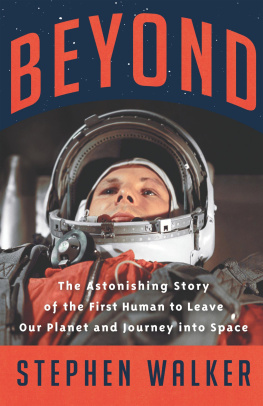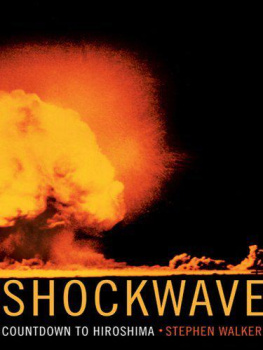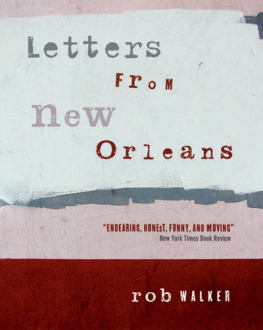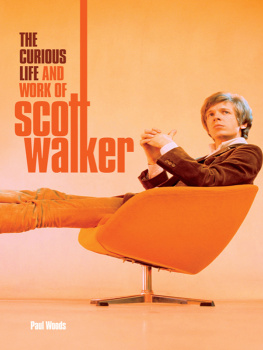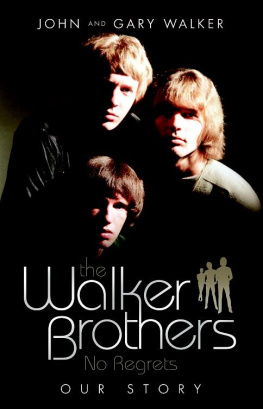Stephen Walker - Beyond
Here you can read online Stephen Walker - Beyond full text of the book (entire story) in english for free. Download pdf and epub, get meaning, cover and reviews about this ebook. year: 2021, genre: Detective and thriller. Description of the work, (preface) as well as reviews are available. Best literature library LitArk.com created for fans of good reading and offers a wide selection of genres:
Romance novel
Science fiction
Adventure
Detective
Science
History
Home and family
Prose
Art
Politics
Computer
Non-fiction
Religion
Business
Children
Humor
Choose a favorite category and find really read worthwhile books. Enjoy immersion in the world of imagination, feel the emotions of the characters or learn something new for yourself, make an fascinating discovery.
- Book:Beyond
- Author:
- Genre:
- Year:2021
- Rating:5 / 5
- Favourites:Add to favourites
- Your mark:
- 100
- 1
- 2
- 3
- 4
- 5
Beyond: summary, description and annotation
We offer to read an annotation, description, summary or preface (depends on what the author of the book "Beyond" wrote himself). If you haven't found the necessary information about the book — write in the comments, we will try to find it.
Beyond — read online for free the complete book (whole text) full work
Below is the text of the book, divided by pages. System saving the place of the last page read, allows you to conveniently read the book "Beyond" online for free, without having to search again every time where you left off. Put a bookmark, and you can go to the page where you finished reading at any time.
Font size:
Interval:
Bookmark:
For my daughter Kitty,
the joy and light of my life
Missile Row, Cape Canaveral (NASA)
Baikonur launch pad (Sergei Kazak/TASS)
Soviet space dog (Lev Porter/TASS)
Miss Baker (NASA)
The chimpanzee Ham in his container (NASA)
Ham in flight (NASA)
Juno rocket explosion, Cape Canaveral (NASA)
The Mercury Seven (NASA)
The Vanguard Six (Russian State Archive of Scientific and Technical Documentation)
John Glenn (NASA)
Alan Shepard (NASA Image Collection/Alamy)
Gherman Titov and Yuri Gagarin (SPUTNIK/Alamy)
Wernher von Braun at periscope (MARKA/Alamy)
Von Braun in Nazi Germany (Bundesarchiv)
Yuri Gagarin and Sergei Korolev (SPUTNIK/Alamy)
Human centrifuge in Bucks County, Pennsylvania (Science History Images/Alamy)
Titov acrobatics (Sputnik/Science Photo Library)
Isolation chamber (Authors collection)
Mercury Control Center (NASA)
Soviet launch bunker (Science History Images/Alamy)
Mercury capsule cockpit (NASA)
Vostok capsule cockpit (123RF)
Vostok in orbit (Zoonar GmbH/Alamy)
Mercury capsule with engineers (Wartimepd/Alamy)
Gagarin medical (Sputnik/Science Photo Library)
Korolevs R7 rocket (SPUTNIK/Alamy)
Gagarin and Titov on bus ride to launch pad (Sputnik/Science Photo Library)
Gagarins launch (Science History Images/Alamy)
Gagarin mobbed after landing (Anatoly Pekarsky)
Charred Vostok sphere after landing (SPUTNIK/Alamy)
Gagarin and Nikita Khrushchev celebrate at Moscow airport (Science History Images/Alamy)
Crowds go wild in Red Square (Sputnik/Science Photo Library)
Shepard in his Mercury capsule (NASA/VRS/Science Photo Library)
The Redstone launch (NASA)
President Kennedy and Jackie watch on live TV (World History Archive/Alamy)
Gagarin filmed with family (Elena Gagarina Photo Archive)
Gagarin with parents (Sputnik/Science Photo Library)
Heroic Gagarin statue Moscow (Felix Lipov/Alamy)
T HE RACE BETWEEN the superpowers to put the first human in space was filled with drama, complete with nail-biting twists and turns and larger-than-life personalities on both sides of the Iron Curtain; so much so that the story that follows might sometimes appear to read like fiction. But it is not fiction. It is a work of history. In writing it I have tried, as far as possible, to sift and verify evidence from a multitude of written, visual and oral sources cited in the endnotes, in order to present the most accurate account I can. Even every line of dialogue has its source. Inevitably there will be errors for which I take full responsibility. But I hope that readers who tread the same path as I have will also find, as so often is the case, that sometimes nothing is more fantastic than reality and certainly not this tale of humanitys first leap beyond the earth.
I have largely avoided giving both US and metric measures at the same time on the grounds that it can interrupt the flow of narrative. My guiding principle, Im afraid not always consistently followed, is to use US measures when the action is located there and metric when in the USSR. To give the distance between, say, New York City and Cape Canaveral in kilometres strikes the same slightly discordant note for me as giving the distance between Moscow and Gzhatsk in miles.
On occasion I use the word Russian when in fact I mean Soviet, a common practice in the west at the time. I have done so to help evoke a particular sentiment or mood. I have also largely avoided the use of the Russian patronymic, except rarely for added emphasis (for example, Yuri Alekseyevich Gagarin). Given that a substantial part of this story takes place in Russia I felt it was more practical for English-language readers if used sparingly.
08.52 APRIL 12, 1961
Mankind will not stay on Earth for ever, but in its quest for light and space it will first humbly penetrate beyond the atmosphere, and then conquer the whole solar system.
Konstantin Tsiolkovsky, Russian scientist and visionary, 1911
Control of space means control of the world.
Senator Lyndon B. Johnson, 1958
April 12, 1961
Scientific and Testing Range No. 5 (NIIP-5)
Tyuratam Cosmodrome, Soviet Republic of Kazakhstan
D AWN COMES QUICKLY in the Kazakh steppe but from one horizon to the other there is almost nobody to witness it. A combination of burning summers and long freezing winters has made this one of the most sparsely populated regions on the planet, a land of emptiness and silence. The wild horses, camels, poisonous spiders and ferocious scorpions have the place to themselves.
Or almost to themselves.
Bisecting this half-desert of wormwood and tumbleweed is the railway line from Moscow to Tashkent, a distance of nearly three thousand kilometres. Two days out from the Soviet capital the train stops briefly at a place called Tyuratam. Legend has it that this was where the body of one of Genghis Khans descendants was discovered in the seventeenth century, floating in the mud-brown Syr Daria river after dying in battle. Before 1955 the only people living here were the stationmaster and his family, and the few Kazakh nomads who moved with the seasons across the steppe, for whom this was a sacred spot. But by 1961, just six years later, everything has changed. An area approximately four times the size of Greater London has been requisitioned by the Soviet ministry of defence for the USSRs most audacious, most expensive and most secret project. A new settlement called Leninsky has sprung up where there was nothing before, home to engineers, soldiers and construction workers and their families, its streets lined with new apartment blocks, administration offices, schools and a barracks. Thirty kilometres to the north are new complexes of assembly and test buildings, a rapidly expanding grid of roads and rail tracks, power pylons, tracking stations, control bunkers and now four giant missile pads. The nomads have long since been expelled. Out here in the middle of nowhere, as far as possible from spying eyes, the Russians are launching rockets.
One such rocket now stands gleaming and hissing as the sun edges above the horizon. Codenamed the R-7, it is the biggest rocket in the world and one of the USSRs most secret weapons. A CIA spy plane attempting to photograph its launch pad last May was shot down; the pilot, Francis Gary Powers, survived to be put on trial for espionage and sentenced to ten years in a Soviet jail. Towering more than 38 metres or 125 feet over the steppe, the R-7 is almost three times as powerful as Americas largest missile, capable of carrying a thermonuclear warhead with the destructive power of two hundred Hiroshima bombs a quarter of the distance around the globe all the way from here to New York.
But this particular R-7 is not going to New York today. Nor is it carrying a nuclear warhead. It has been adapted for a different purpose. At 09.07 Moscow time its five massive first and core-stage engines will ignite and, if nothing goes wrong, the rocket will launch into space. Instead of a warhead it will carry a spherical capsule inside which will sit or rather lie a man. The man will be short, no more than five feet five inches, and light too, since his capsule will be approximately the weight of the five-megaton nuclear bomb it is replacing. He will have trained for over a year to accomplish this mission. And he will have to be brave. No human has been in space before. Nobody knows exactly what will happen when he gets up there if he gets up there. Will his eyeballs burst? Will his blood stop circulating? Will he survive the crushing acceleration forces of launch enough to drain the blood from his head? Will the heatshield of his metal sphere withstand the 1,500-degree Celsius temperatures of re-entry? Will his rocket blow up, as some of its predecessors have done in earlier test flights? And if he does make it up there, divorced from life and existence as no human being has been before, will he go mad?
Next pageFont size:
Interval:
Bookmark:
Similar books «Beyond»
Look at similar books to Beyond. We have selected literature similar in name and meaning in the hope of providing readers with more options to find new, interesting, not yet read works.
Discussion, reviews of the book Beyond and just readers' own opinions. Leave your comments, write what you think about the work, its meaning or the main characters. Specify what exactly you liked and what you didn't like, and why you think so.

